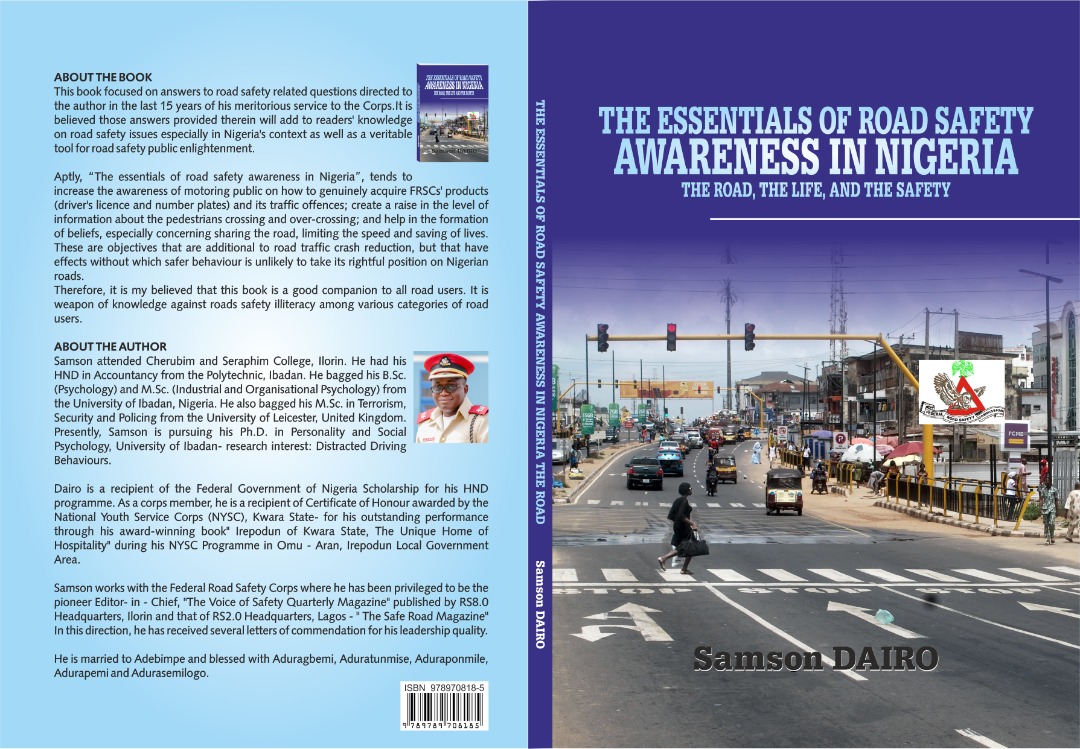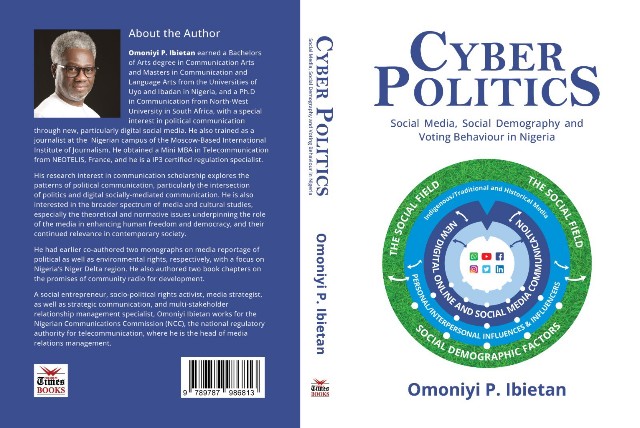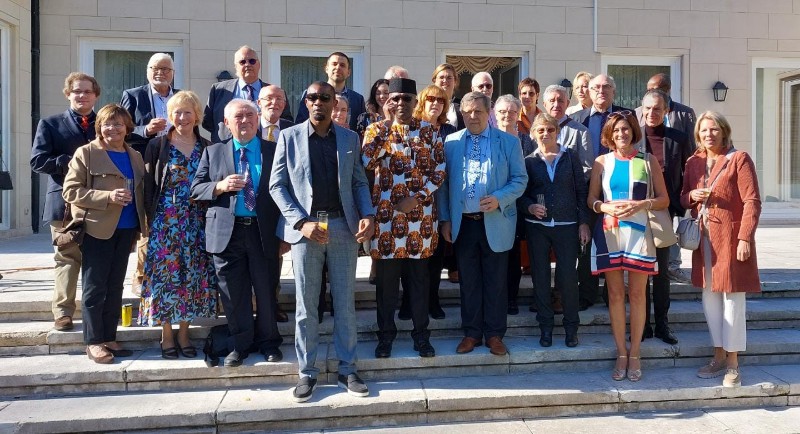Introduction: Background to the book
Title of book: The Essentials of Road Safety Awareness in Nigeria: The Road, The Life and The Safety
Writer: Superintendent Route Commander Samson Dairo.
Publisher: Dairock Press, Ibadan, Nigeria.
No of chapters: 7; with Dedication, Acknowledgments and Preface
Foreword: by Dr. Boboye Oyeyemi, MFR, mni, NPoM, the Corps Marshal of the Federal Road Safety Corps of Nigeria.
Acknowledgements: The author expressed his gratitude to numerous people who have helped him in his career progression. He is particularly grateful to Dr. Boboye, whom he described as a “unique master and mentor,” the “strong pillar” behind his success.
The book ends with a Conclusion, an Epilogue and References.
The author is a prolific writer who has written several other books.
Having provided this background information about the book and its author, I now undertake the review proper.
2.1 Chapter By Chapter Review:
Chapter 1: Enhancing Road Sense Through Road Safety Awareness Campaigns.
The motto of the FRSC is: “Creating a safe motoring environment in Nigeria.” This it does by creating safety on our roads and highways.
The Value Of The Road
The road is crucial to human survival; for what can we possible do without the road?
We move on the road – by foot or some form of conveyance, including on motor vehicle, cart, bicycle, or horse. Modern roads are normally smoothed, paved, or otherwise prepared to allow easy travel.
A Fact:
The oldest constructed roads were in Mesopotamia –present day Iraq. They were stone paved streets dating back to around 4000 B.C.
Economic Value Of Roads
Roads make a crucial contribution to economic development and growth of a nation. Road infrastructure is the most important of all public assets. Roads have important social benefits.
Roads provide access to employment, thereby helping to fight poverty. A look at the European road network shows that it consists of 5.5 million km with an estimated value of over €8,000 billion.
Question: What is this book telling us?
“The ROAD is an embodiment of the right to life”. Hence, we must ensure safety on the road
But, What Is “Road Safety”?
Chapter1 defines it as “… safety in using the roads through road sense”
The Concept Of Road Sense:
Road sense is a central concept in the book. It refers to “the ability to display reasonable skills while driving, cycling or walking” on the road.
A person has road sense when he/she uses the road in ways that promote not only personal safety but also the wellbeing of other road users.
Carnage on the road will be greatly reduced if all of us as road users display some modicum of “road sense” while transiting on the road!
Safety As The Goal Of FRSC
The chapter reminds us that “the Federal Road Safety Corps came into existence to inculcate good driving culture tailored towards promoting sanity and safety on Nigerian roads when the rate of carnage was a national disaster” (p. 1). “Sanity and safety” are two important words that capture the essence of this book.
Chapter 2: The Pedestrian Crossing and Over-Crossing
This book educates you – it takes away the veil of ignorance hindering our knowledge about road use. It defines who a pedestrian is, what a pedestrian crossing or crosswalk means. I knew what a “pedestrian crossing” was; but I didn’t know that there is something called “over-crossing”! I learnt about this in the book!
Did you know that the first pedestrian bridge in Nigeria was erected close to Idumota in Lagos? I’m sure many of us didn’t know this historical fact. It is found in the book!
Types of pedestrian crossing – six types: school crossing, zebra, pelican, puffin, toucan and Pegasus. Grab a copy of the book and learn more about all these.
Reason For Pedestrian Crossing:
To provide safe mode of movement for pedestrians without obstructing the speed or movement of vehicular traffic or waterways. When properly used, such crossings help reduce pedestrian accidents and death.
Chapter 3: Share The Road, Limit The Speed And Save The Lives
I like the title of the chapter. It is poetic and epigrammatic. The chapter is simply telling us that the road belongs to everyone, not just to a single individual. Hence, each user has a duty to share it with others, to limit his/her speed by employing road sense – this way, lives will be saved.
Respect For Persons (Ethics):
Respect for persons is a key ethical principle. To respect persons implies valuing their lives and personal integrity
It means, according to Immanuel Kant, never to use humans as means but always as ends. To say I respect you will mean that I will use the road in a way that I will not hurt your life.
I quote from the book: “A driver getting to his destination is the reward for safe driving, while the beauty of safe driving is in sharing of the road.”; “The safety of road users is indispensable”.
Drivers should not turn the road into “a race course”; “Share the road because every life counts.” Sharing the road is a way to show respect, care and consideration for other road users, etc.
Pictorial Illustrations:
The chapter contains pictures of wrecked vehicles that were involved in horrible road crashes/accidents
In many of the crashes, lives were lost!
Over-speeding is usually the reason for many road crashes. When drivers over-speed, they find it difficult to stabilize their vehicles when emergencies arise.
There is a quotation from a 2015 lecture given Dr. Boboye to the effect that: “Speeding is the most causative factor responsible for road traffic crashes on Nigerian roads and speed induced crashes stand at 50.8 per cent” (p. 15).
Explaining further, the author reminds everyone that, “For the families of those killed in road traffic crash where speed is a factor, the impact can last a lifetime.”
The chapter concludes with a list of frequently asked questions on Speed Limiting Device (see p. 15).
Chapter 4: Educating The Motoring Public On FRSC’s Products And Traffic Offences
The chapter contains a detailed discussion on the type of products or services the FRSC offers to the public such as the issue of how to obtain a drivers’ licence.
The Drivers’ Licence
The issuance of the Drivers’ Licence is one of the major services rendered by the FRSC. It is also one of the major areas where people face the most delay.
Many drivers complain of delay in obtaining their drivers’ licence or being captured under the FRSC’s Integrated Capturing System (ICY).
The chapter explains how people can overcome the difficulties faced in obtaining their genuine Drivers’ Licence.
The chapter addressed some frequently asked questions by drivers; there is a discussion on FRSC’s computer-based test for licence plate applicants; on how to upgrade existing drivers licence; on methods for making payment for people applying for drivers licence, etc.
The Central Chapter…
I consider Chapter 4 the central chapter in the book. Why?
In the chapter, the author explained the procedures for obtaining the Drivers Licence; drivers face some delays in this area. However, the author explained how issues of delay in obtaining the licence plate can be tackled.
A Plea To The Public:
Chapter 4 is also where the author pleaded with drivers licence applicants thus: “I therefore enjoin drivers licence applicants to give the FRSC the needed support and understanding in order to for the Corps to deliver better services to the public.”
Chapter 5: Obstruction: An Impediment To Safety
The road is not supposed to be a death-trap. Every traveler desires safety on the road, but unfortunately, many lose their lives on the road. Why? Because of human factor or the carelessness of other road users.
Traffic obstruction is often responsible for loss of life on our roads. We infringe on the rights of other road users when we abandon or park our vehicles on the road; when we fail to display caution sign to alert other drivers that our broken vehicle broke down on the highway; when we turn the road into avenues for parties or merry-makings; when the road is turned into a trading place by hawkers, etc.
The book states in unequivocal terms that traffic obstruction is “venom,” and a “monster” that we must all join hands to eradicate!
Chapter 6: Overloading: We All Must Avoid It!
The chapter discussed overloading which is another life waster on our roads.
It is an offence! Overloading endangers your life and other people’s lives.
Overloading is an offence punishable by law. We must all say NO to overloading.
Chapter 7: Operational War Against Rickety Vehicles
Chapter 7 discussed the problem of rickety vehicles which are a menace on our roads. They are also a danger to safety on the road, and we must all work together to eradicate this problem.
3.1 Final Words
The book is well-written; the language is straightforward and easy to understand
The author used pictorial images to vivify his message.
Pictures leave a lasting impression on the mind of the reader. In pedagogy, pictures are veritable tools for teaching important lessons, especially to young people.
There are quotable quotes on the ideal of safety on the road, e.g., Archbishop Desmond Tutu’s statement that “…road crash is predominantly a killer of the poor…” (p. 9). This is both apt and illustrative.
4.1 Recommendation:
This book must not be left to lie on the shelf; rather, it should circulate everywhere. Let all those who use the road have a copy.
I recommend the book, “The Essentials of Road Safety Awareness In Nigeria: The Road, The Life and The Safety”, to all and sundry.
•Agulanna, PhD, is a Professor of Ethics and Social Philosophy, Department of Philosophy, University of Ibadan.
16 June, 2022.


































